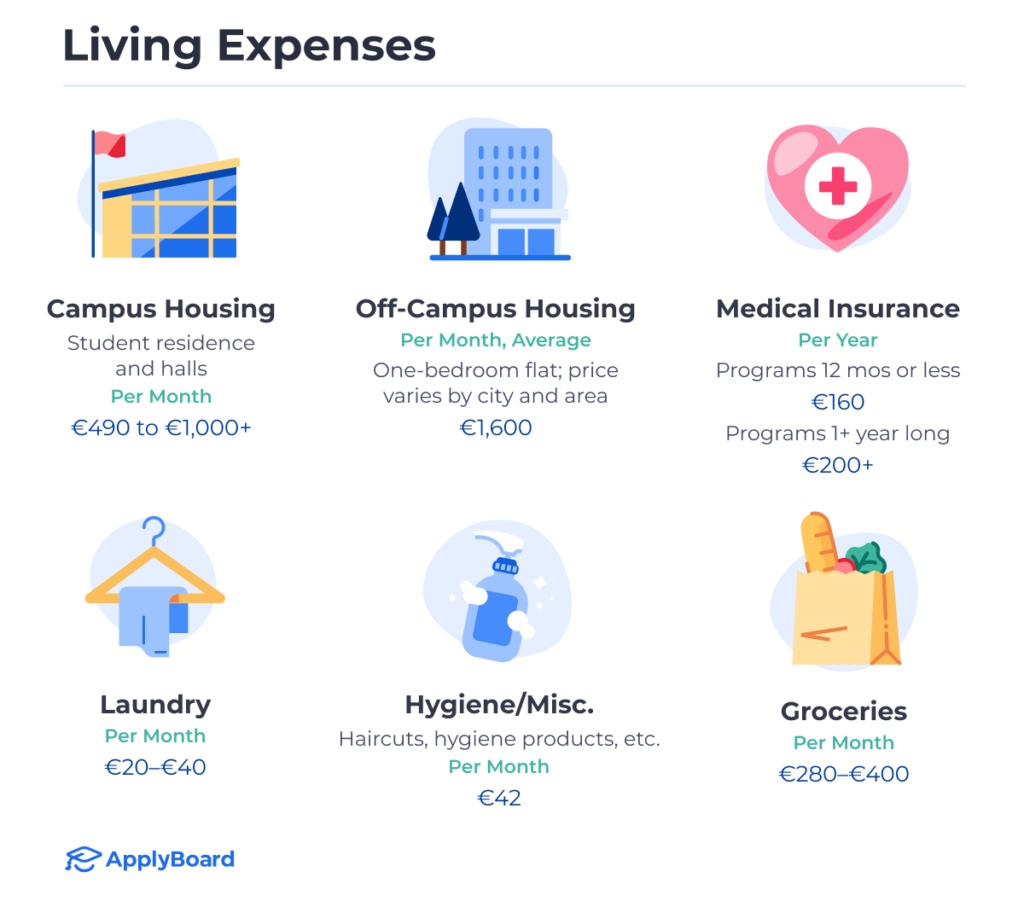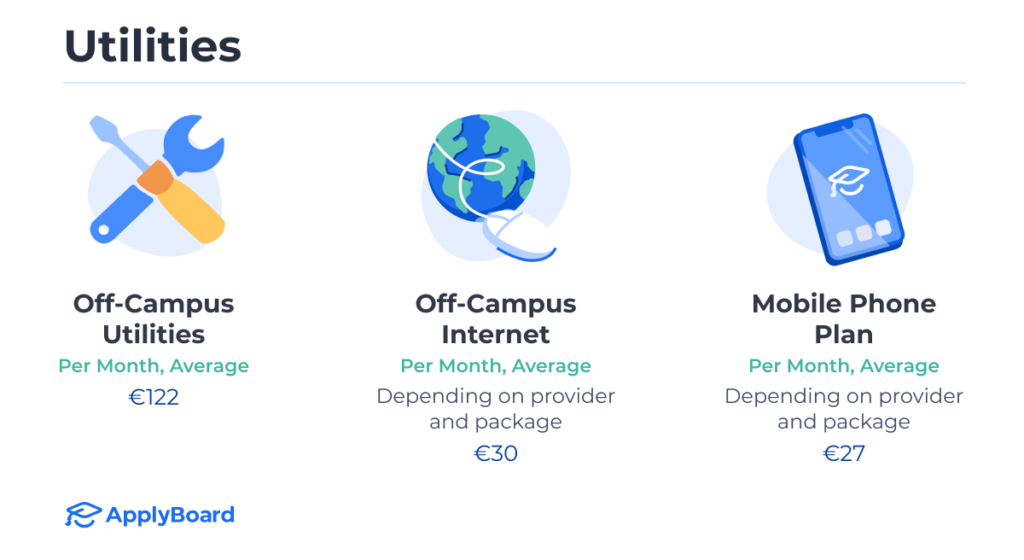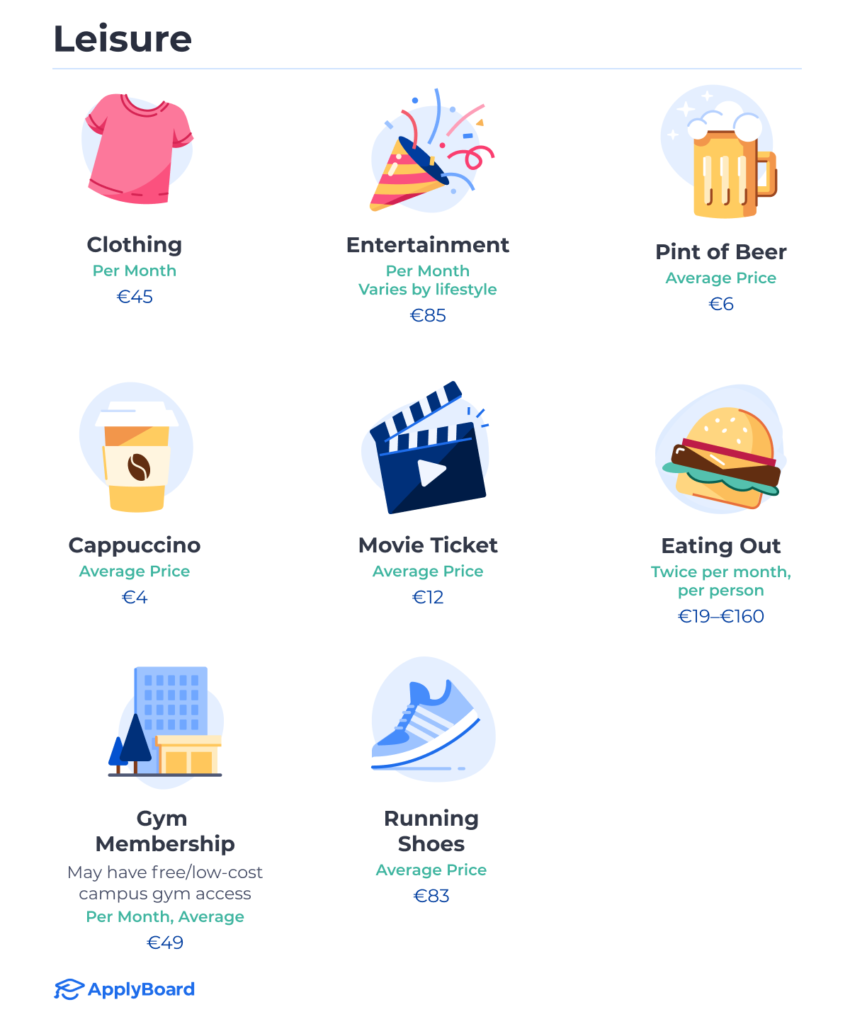The cost of living in Ireland for international students is key to consider when planning your study abroad journey. While Ireland offers high-quality education and a welcoming environment to all its students, overall expenses can vary significantly depending on the community students move to and their individual lifestyle. Below, we’ll look at some of the most common expenses that international students should plan for.
While these costs are current as of September 2024, check a cost of living calculator before you start drafting your budget, as average prices change regularly.
From top-ranked institutions to excellent graduate employment rates, there are lots of great reasons to study in Ireland.

Living Expenses
Next to tuition, the biggest expense for international students in Ireland is housing. Monthly rent prices are generally higher in a larger city like Dublin, and lower in smaller communities like Limerick or Waterford. Student residences on or near campuses are appealing options, but availability is limited and competition for a room can be high.
On average, international students spend around the following for essential living expenses:1

You can manage your food costs by shopping carefully. A student living in Ireland might spend between €280 and €400 per month on food, depending on their dietary preferences and shopping habits. Supermarkets like Aldi and Lidl offer affordable prices for essential items, while Tesco and Dunnes Stores have more selection at a slightly higher price range.
If you’re planning to study in Ireland, and aren’t from the European Union, you must show proof of purchasing health coverage to get your Irish student visa. Importantly, you must also maintain your health insurance coverage until you leave Ireland. In general, health insurance for international students costs around €160 for programs of 12 months or less. Insurance plans for students staying in Ireland for over a year range will cost €200+ per year.
Tip: Talk with your institution to understand what kind of medical insurance you need. They may be able to help you pick a suitable plan, as there are many options.

Utilities
In addition to rent, students need to account for utilities like electricity, heating, water, and waste management in their budget. Some student residences will include heat and electricity in their initial charge, and deduct payment from your security deposit if you use more than average.
Remember to budget for modern utilities: across Ireland, internet and mobile phone plans vary, but average about €30 per month. If you have a television, you’ll also need to pay €160 per year for a TV license. As you arrive, visit different phone and internet provider websites for deals for international students, especially if you’re starting your studies in September.
Utility bills average about €120 every month. They will vary depending on things like the age of your building, the size of your rental unit, the local climate, and how many roommates you have. Here are some average costs:2

Tip: When you move in, ask your building manager what the average monthly utility cost is. If your bills are consistently higher, something might need to be repaired, like a leaky tap or unsealed window.
From internships to which programs allow international students to work, check out our blog on how to work while studying in Ireland!

Leisure
Living in Ireland will give you plenty of opportunities for meeting friends, exploring cultural sites, and attending events. Plus, because Ireland is a great jumping-off point to the rest of Europe, many students explore new countries and cultures during long weekends or the breaks between terms. (Thinking about travel? Plan ahead, as you’ll need a Schengen visa to travel to other countries in the EU.)
Whether you’re visiting local attractions or shopping for essentials, remember to check for student discounts! Some will be available to every student, where others may be accessed by signing up for a student price card like the International Student Identity Card which gives you special pricing on everything from restaurants to hostels.
While your leisure costs will vary depending on your lifestyle, here’s a quick look at popular expenses:3

From thrifting to volunteering, here are some of our top tips for making the most of your student budget.

Transportation
Public transportation in Ireland is reliable. Many students who travel by bus or commuter rail will buy a Young Adult or Student Leap Card, which gives them 50% off adult transit rates.
For students who prefer cycling, many cities have bike-sharing schemes at a reduced rate. For example, Dublin Bikes offers an annual subscription for €35, and the first 30 minutes of every journey is free. Or, buy a bicycle for more convenience. Take a closer look at some average transportation costs:4

Academic Supplies
The cost of your academic supplies may vary based on your field of study. For example, classes with a lab component can cost more to cover experiment materials. In general, it’s smart to start searching for textbooks as soon as you receive your reading list for the semester. Try to rent books if you can, or see if they’re available from a campus library for a long-term loan. Or, buy them second-hand from your academic institution’s bookstore, Unibooks, Bookfinder, or Facebook Marketplace.
If you’re buying books from someone online and picking them up in person, be safe: go with a friend to do a porch pick-up or meet somewhere public on campus. Depending on your field of study, the cost of your supplies may differ from term to term as well:5

Total Living Expenses
Overall, an international student living in Ireland should budget between €10,000 to €20,000 per academic year (nine months) for living expenses. As the capital city, Dublin is the most expensive place to live, while smaller cities and towns offer a more affordable cost of living.
Financial Planning Tips
- Share accommodation: Reduce rent costs by sharing housing with other students.
- Cook at home: Prepare meals at home instead of dining out to save on food.
- Use student discounts: Ireland offers many discounts on public transport, entertainment, and cultural sites for students with a valid student card.

While Ireland may have a higher cost of living than other European countries, it remains a top destination for international students due to its vibrant culture, excellent education system, and opportunities for work after graduation. With smart financial choices, students can enjoy their time studying in Ireland without breaking the bank.
Take the next step: explore the free ApplyBoard platform to find a study program that fits your goals.
FOOTNOTES:
1. Sources: University College Cork, “UCC Castlewhite Apartments, 2023–2024 school year.” (on-campus housing); Irish Council for International Students, “Cost of Living for Students in Ireland.” Accessed September 2024. (on-campus housing, laundry, groceries); Numbeo, “Cost of Living in Ireland.” (off-campus housing); Dublin Business School, “Medical Insurance.” (health care); Government of Ireland, “Reasonable Living Expenses – Background Information 2022.” (personal hygiene)
2. Source: Shauna Bowers, The Irish Times. “How expensive is college?” January 17, 2024.
3. Sources: All numbers in this chart were sourced from the Numbeo, “Cost of Living in Ireland” results for September 2024, except: Shauna Bowers, The Irish Times. “How expensive is college?” January 17, 2024 (clothing) and Technological University Dublin, “Cost of Living Guide.” (entertainment)
4. Sources: Technological University Dublin, “Cost of Living Guide.” (public transportation) and Sport Ireland, “Choosing and Buying a Bike.”
5. Source: Arife Klopman, “How Much Does it Cost to Study in Ireland?” September 19, 2023.







